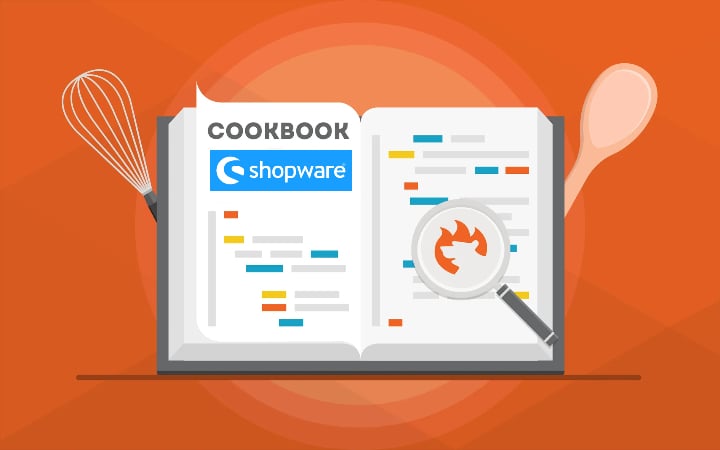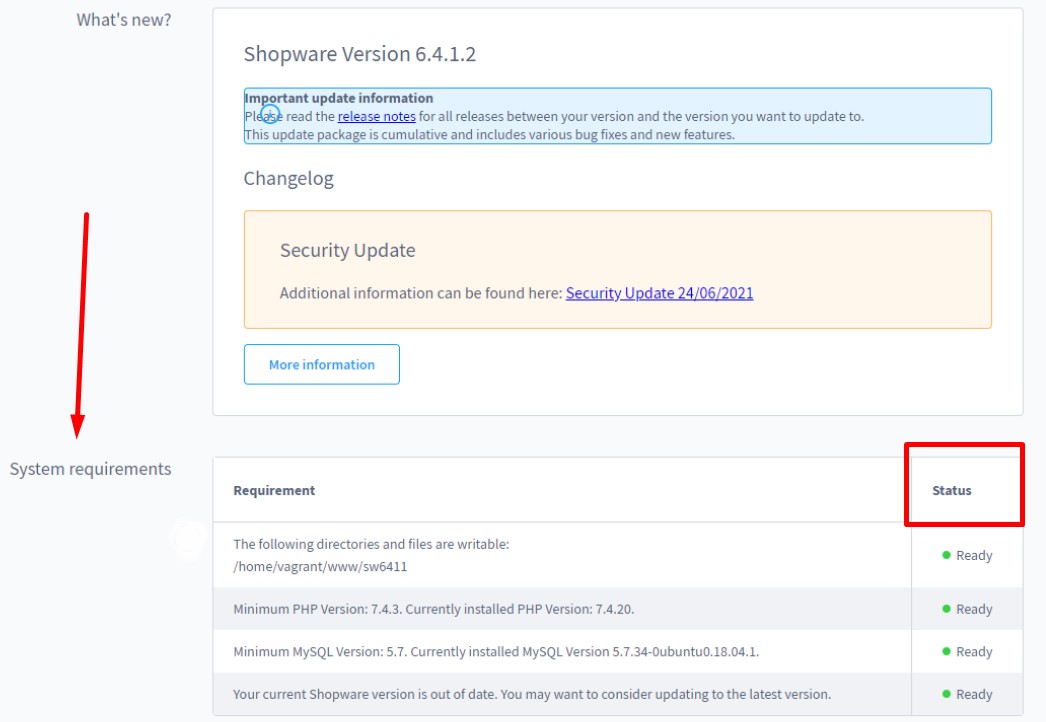How To Update Shopware 6 In Administration

In the following article, we shed light on how to upgrade your Shopware 6 website to the latest version right in the administration section of your e-commerce website. Although you won’t need to apply complex manipulations using the shell, we insist that every Shopware update falls within the ambit of experienced specialists familiar with the challenge. Below, we shed light on how to secure your Shopware 6 update and maintain the extension compatibility. After that, you will explore the upgrade procedure that takes place in your administration and consists of the following steps: you will look for the update, check the system requirements, deactivate extensions, and update the system. So, let’s run through the preparations and see how to update Shopware 6 right in the administration. You can find more similar materials here.

Note that we provide Shopware integration with external platforms. Contact our support for further information or try our Improved Import, Export & Mass Actions.
Table of contents
- 1 How To Secure Shopware 6 Update
- 2 Maintain The Extension Compatibility
- 3 How To Update Shopware 6 In Administration
- 4 Shopware 6 Essentials FAQ
- 4.1 How to create a Shopware account?
- 4.2 What about a Shopware ID?
- 4.3 What is Shopware master data?
- 4.4 How to add a new Shopware shop?
- 4.5 How to add a payment method to your Shopware account?
- 4.6 How to create a deposit in Shopware?
- 4.7 How to purchase Shopware extensions?
- 4.8 How to get support in Shopware?
- 4.9 How to automate import and export processes in Shopware 6?
- 4.10 How to migrate to Shopware 6?
- 4.11 How to integrate Shopware 6 with external systems?
How To Secure Shopware 6 Update
What is the most important security rule required for any system update? You need to create a backup to roll back if something goes wrong during the upgrade process. However, Shopware does not create backups.
Considering this situation, setting up backups on your server is vital. You need to contact your hosting partner, who usually looks out for your server. Although they may create the backups, you always need to figure out the nuances.
Now, when the backup of your e-commerce website is ready, you need to apply the update to your test environment first. Thus, you will see how safe the process is and what improvements it brings. If something goes wrong, it won’t affect your production website. If it does so, you have a backup that can be restored. If you don’t know how to create a test environment, follow this link: How To Create Test Environment For Shopware 6.
System requirements are another essential aspect of every update. Every new Shopware version may have different system requirements. Therefore, it is necessary to check them before applying the update. You can find the latest system requirements .
Maintain The Extension Compatibility
Note that your installed extensions may impact the update dramatically. They should always be compatible with the Shopware version you will upgrade to. Updating them to the latest version usually helps. In the worst-case scenario, you may need to recover your e-commerce website from the backup due to incompatible extensions that break the system. But there is a simple method to maintain the extension compatibility in Shopware 6.
Visit the Shopware , open the Auto-Updater in the admin, or proceed to your Shopware Account at Licenses. In any case, you can check with what Shopware versions your extensions are compatible with. If their current versions don’t support the update, upgrade the modules.
Chances are, the latest plugin’s version may also be incompatible. You need to contact the extension provider to discuss the issue.
How To Update Shopware 6 In Administration
Shiopware 6 provides the ability to apply an update directly in the administration. Go to Settings -> System -> Shopware Update to see your current version and upgrade to the latest one (it is the only possible option).
Note that the “Update Code” field is necessary in individual cases when the support team provides the code to install a specific bug fix, etc.
I: Check for updates
Under Settings -> System -> Shopware Update, you can see the Check for updates button. Click it to see whether you can upgrade your e-commerce store to the latest version. If the update is possible, proceed to the next step.
II: System requirements
Shopware 6 checks the system requirements automatically before applying the update. In the Status column, you can find all problematic areas incompatible with the update. Adjust them before going any further.
III: Extension compatibility
Now, you need to look through your extensions one more time. Deactivate tools that are not compatible with the update. After that, you can proceed to the installation.
IV: Install the update
Follow the steps in the wizard to install the update.

If everything is installed successfully, you will see the green ticks on the left side along with the following message:
After that, you can proceed to the frontend to see whether everything works correctly.
Also, check how to update Shopware 6 through the shell and browser.
Shopware 6 Essentials FAQ
How to create a Shopware account?
You won’t run any updates in the admin if you don’t have a Shopware account. However, creating it is a matter of a few clicks. Visit the registration page, hit the Register Now link, and fill in the form to create a new account. After receiving a confirmation email, follow the instructions provided in it.
What about a Shopware ID?
You will receive a Shopware ID upon registration automatically. Next, you will need to install a Shopware store to apply updates in the administration.
What is Shopware master data?
All the information about your company and business, including physical addresses, phone numbers, and emails, is master data. The system requires it during the registration and configuration. Neither updates in the admin nor browser or shell affect it.
How to add a new Shopware shop?
You need to create a shop to apply updates in the admin to it. It is possible to add it to your merchant area. Click the corresponding link and choose the type of your new shop: a cloud storefront or an on-premise installation. The latter requires updates similar to the one we’ve described above. Provide all the requested information.
How to add a payment method to your Shopware account?
You need to add a payment method to purchase themes and extensions (don’t forget that the installed plugins should be compatible with the update). You can add a payment method to purchase them under Basic Information -> Accounting. Select PayPal, credit card, or direct debit as a way to transfer funds to your account.
How to create a deposit in Shopware?
You need a deposit for purchasing commercial third-party extensions and themes. With a working payment method, go to your Merchant Area -> Shops, choose a shop to provide funds to, click Open Account Details, and transfer a deposit that covers the amount of your purchase.
How to purchase Shopware extensions?
It is possible to purchase extensions and themes in two ways: on the Shopware Marketplace or within the Plugin Manager (you can also view their compatibility with the update there). Create a deposit in advance that equals the amount of your future purchase. Next, select a tool you want to buy and complete the checkout.
How to get support in Shopware?
You can get help regarding license inquiries here: info@shopware.com or call +49 2555 9288 50. Contact Shopware via financial.services@shopware.com and +49 2555 9288 510 for support regarding accounting and financial issues.
How to automate import and export processes in Shopware 6?
If you need to tame recurring data transfers, then the Improved Import, Export & Mass Actions module is suitable. It lets you create schedules and automatically launches the corresponding import and export processes in the background afterward.
How to migrate to Shopware 6?
You can also use the Improved Import, Export & Mass Actions tool to simplify the Shopware 6 migration. It can help you transfer data from your existing website based on another e-commerce platform or a previous Shopware version to Shopware 6. Note that we also offer export solutions for systems like Magento and Shopify so that you can simplify your data transfers between them and Shopware. for more information.
How to integrate Shopware 6 with external systems?
It is possible to sync your Shopware 6 website with ERPs, CRMs, accounting tools, and other similar platforms. You need the Improved Import, Export & Mass Actions plugin. It can help you automate repetitive import and export processes using schedules. The extension also introduces mapping presets for modifying data according to the requirements of your Shopware store during import and the rules of the connected platform during export.













